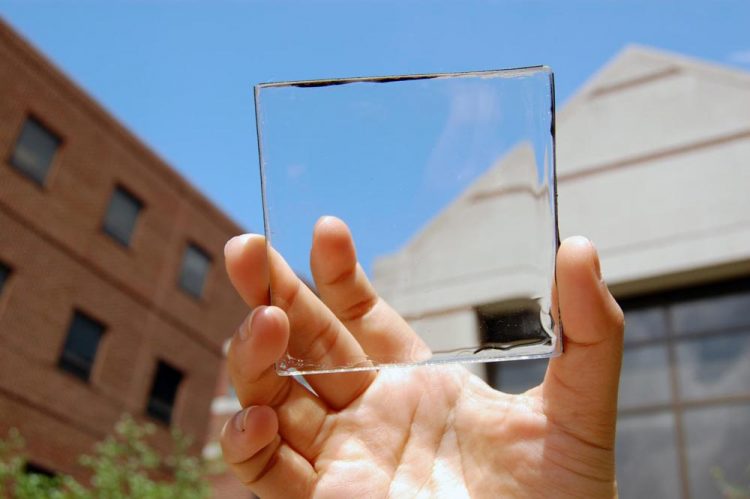Transparent solar technology represents 'wave of the future'

See-through solar-harvesting applications, such as this module pioneered at Michigan State University, could potentially produce 40 percent of U.S. electricity demand. Credit: Michigan State University
Led by engineering researchers at Michigan State University, the authors argue that widespread use of such highly transparent solar applications, together with the rooftop units, could nearly meet U.S. electricity demand and drastically reduce the use of fossil fuels.
“Highly transparent solar cells represent the wave of the future for new solar applications,” said Richard Lunt, the Johansen Crosby Endowed Associate Professor of Chemical Engineering and Materials Science at MSU. “We analyzed their potential and show that by harvesting only invisible light, these devices can provide a similar electricity-generation potential as rooftop solar while providing additional functionality to enhance the efficiency of buildings, automobiles and mobile electronics.”
Lunt and colleagues at MSU pioneered the development of a transparent luminescent solar concentrator that when placed on a window creates solar energy without disrupting the view. The thin, plastic-like material can be used on buildings, car windows, cell phones or other devices with a clear surface.
The solar-harvesting system uses organic molecules developed by Lunt and his team to absorb invisible wavelengths of sunlight. The researchers can “tune” these materials to pick up just the ultraviolet and the near-infrared wavelengths that then convert this energy into electricity.
Moving global energy consumption away from fossil fuels will require such innovative and cost-effective renewable energy technologies. Only about 1.5 percent of electricity demand in the United States and globally is produced by solar power.
But in terms of overall electricity potential, the authors note that there is an estimated 5 billion to 7 billion square meters of glass surface in the United States. And with that much glass to cover, transparent solar technologies have the potential of supplying some 40 percent of energy demand in the U.S. – about the same potential as rooftop solar units. “The complimentary deployment of both technologies,” Lunt said, “could get us close to 100 percent of our demand if we also improve energy storage.”
Lunt said highly transparent solar applications are recording efficiencies above 5 percent, while traditional solar panels typically are about 15 percent to 18 percent efficient. Although transparent solar technologies will never be more efficient at converting solar energy to electricity than their opaque counterparts, they can get close and offer the potential to be applied to a lot more additional surface area, he said.
Right now, transparent solar technologies are only at about a third of their realistic overall potential, Lunt added.
“That is what we are working towards,” he said. “Traditional solar applications have been actively researched for over five decades, yet we have only been working on these highly transparent solar cells for about five years. Ultimately, this technology offers a promising route to inexpensive, widespread solar adoption on small and large surfaces that were previously inaccessible.”
###
The work is funded by the National Science Foundation and the U.S. Department of Education.
Lunt's coauthors are Christopher Traverse, a doctoral student in engineering at MSU, and Richa Pandey and Miles Barr with Ubiquitous Energy Inc., a company Lunt cofounded with Barr to commercialize transparent solar technologies.
Media Contact
All latest news from the category: Power and Electrical Engineering
This topic covers issues related to energy generation, conversion, transportation and consumption and how the industry is addressing the challenge of energy efficiency in general.
innovations-report provides in-depth and informative reports and articles on subjects ranging from wind energy, fuel cell technology, solar energy, geothermal energy, petroleum, gas, nuclear engineering, alternative energy and energy efficiency to fusion, hydrogen and superconductor technologies.
Newest articles

A ‘language’ for ML models to predict nanopore properties
A large number of 2D materials like graphene can have nanopores – small holes formed by missing atoms through which foreign substances can pass. The properties of these nanopores dictate many…

Clinically validated, wearable ultrasound patch
… for continuous blood pressure monitoring. A team of researchers at the University of California San Diego has developed a new and improved wearable ultrasound patch for continuous and noninvasive…

A new puzzle piece for string theory research
Dr. Ksenia Fedosova from the Cluster of Excellence Mathematics Münster, along with an international research team, has proven a conjecture in string theory that physicists had proposed regarding certain equations….



